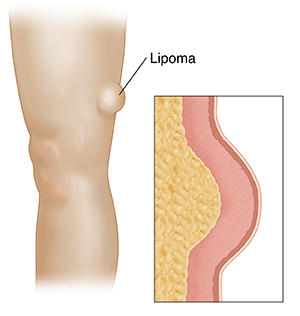Understanding a Lipoma
Understanding a Lipoma

A lipoma is a lump under the skin that’s made of fat. It’s not cancer (benign). It feels soft like rubber when you press it, and in most cases it doesn’t hurt. Some people have more than one. A lipoma grows slowly over time and doesn’t cause many problems. Lipomas occur most often in adults from ages 40 to 60. They are more common in men.
How to say it
Ly-POH-mah
What causes a lipoma?
Experts don't know yet what causes lipomas. They are still learning more. They may be partly caused by a problem in a gene. They can run in families. Familial multiple lipomatosis is when 2 or more family members have many lipomas.
Symptoms of a lipoma
The main symptom of a lipoma is a soft lump under the skin that doesn’t hurt unless it is pressing on a nerve. It may be small, around 1/4 inch across. Or it may be larger, up to 4 inches across or more.
There are different kinds of lipomas. The most common kind occurs under the skin of the shoulders, chest, back, belly, or under the arms. In some cases, a lipoma can occur on the legs. In rare cases, one may occur deeper in the body or in a muscle.
Treatment for a lipoma
In most cases, a lipoma doesn’t need treatment. Your healthcare provider may look at it during regular checkups to see if it changes.
But if the lipoma is painful or you want it removed for cosmetic reasons, it can be removed with surgery. The surgery is called excision. The lipoma will most likely not grow back after surgery. During surgery, the area around the lipoma is numbed. If you have a deep lipoma, you may need medicine to numb a larger area (regional anesthesia). Or you may need medicine to put you to sleep during the procedure (general anesthesia). Then the doctor makes a cut over the area of the lipoma. He or she removes the lump of fat. The cut is then closed with stitches.
Possible complications of a lipoma
A large lipoma inside the body can press on organs, nerves, or other tissues and cause problems. For example, it can cause problems with breathing or digestion.
Living with a lipoma
Your healthcare provider may look at the lipoma during regular checkups to see if it changes or is causing problems.
When to call your healthcare provider
Call your healthcare provider right away if you have any of these:
-
Lipoma that grows quickly, causes pain, or feels hard
-
New lipomas
Updated:
November 05, 2018
Sources:
Brinster NK, et al. Lipoma. In: Brinster K, editor. Dermatopathology: High-Yield Pathology. Philadelphia: Saunders; 2011. p. 527-8., Goldblum JR, et al. Benign Lipomatous Tumors. In: Goldblum JR, editor. Enzinger and Weiss's Soft Tissue Tumors. 6 ed. Philadelphia: Saunders; 2014. p. 443-83., Goldstein BG, et al. Overview of benign lesions of the skin. Up to Date. November 11 ed: Up To Date; 2015. p. 105., Karnes J, et al. Cysts and Lipomas. In: Usatine R, editor. Dermatologic and Cosmetic Procedures in Office Practice. Philadelphia: Saunders; 2012. p. 133-45.
Reviewed By:
Michael Lehrer MD,Rita Sather RN,Raymond Kent Turley BSN MSN RN